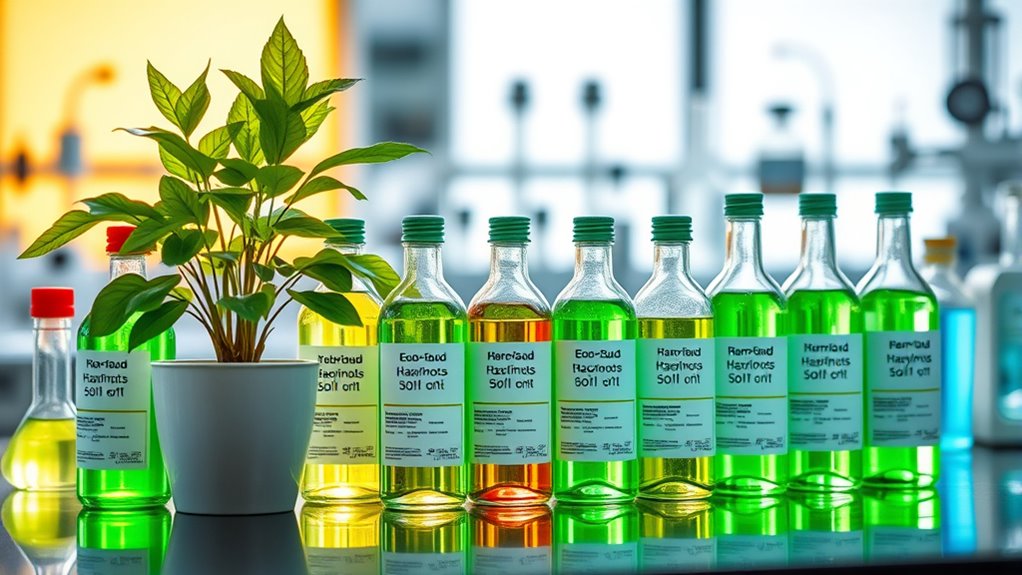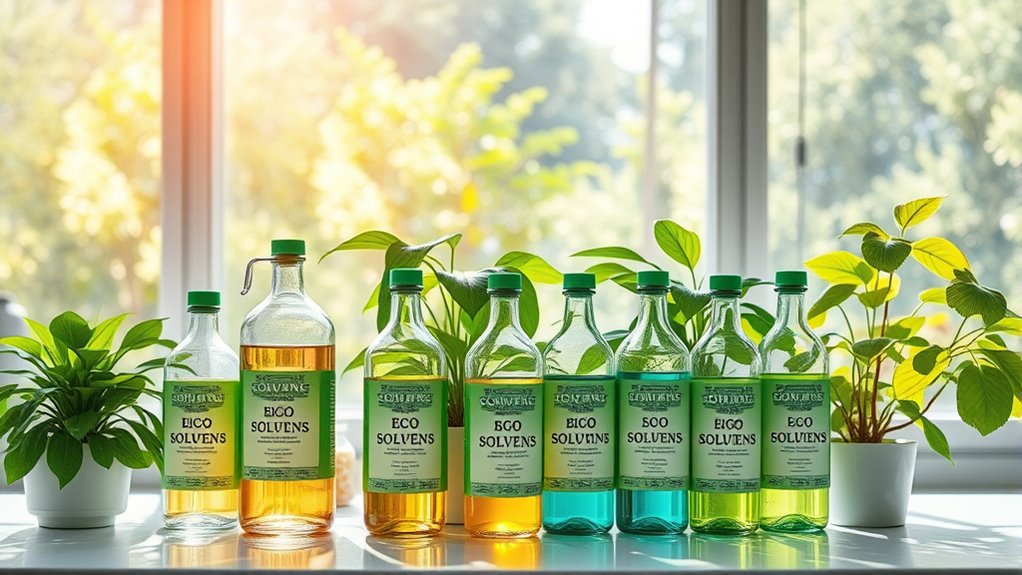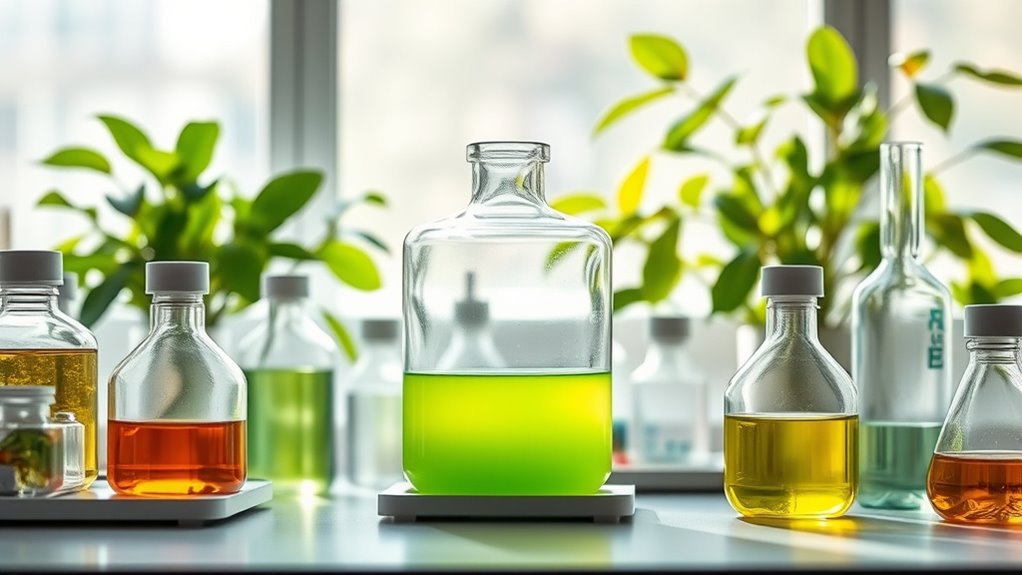Switching to safer, greener solvents helps reduce health risks and environmental harm in your processes. Instead of hazardous chemicals, options like water, supercritical CO₂, ionic liquids, and bio-based solvents offer effective, biodegradable alternatives. These eco-friendly choices cut toxicity, emissions, and waste, saving costs and improving safety. If you want to discover how these sustainable solvents can benefit your operations and sustainability goals, there’s more to explore below.
Key Takeaways
- Green solvents like water, supercritical CO₂, and ionic liquids reduce toxicity, volatility, and environmental impact compared to hazardous chemicals.
- These eco-friendly alternatives support sustainability through renewable sourcing, biodegradability, and recyclability.
- Safer solvents lower health risks for workers, minimize pollution, and decrease long-term ecological damage.
- Implementing green solvents can improve process efficiency, reduce waste, and lower operational costs.
- Selecting sustainable solvents involves evaluating lifecycle impacts, safety profiles, and compatibility with industrial processes.
Understanding the Need for Green Solvents

Why is there an urgent need to shift toward green solvents? Traditional solvents pose serious health and environmental risks. They’re often highly toxic, exposing workers and nearby communities to hazards, and contribute to air, water, and soil pollution through emissions and improper disposal. Green solvents are derived from renewable resources, reducing reliance on finite fossil fuels and supporting sustainable practices. Persistent organic pollutants from these solvents bioaccumulate, causing long-term ecological damage. Exposure to volatile organic compounds (VOCs) can lead to respiratory and neurological issues. Additionally, solvent emissions during industrial processes create significant environmental cleanup challenges. Eco-friendly solvent alternatives offer a safer option; they tend to be non-toxic, biodegradable, and less volatile, reducing harmful emissions and pollution. Switching to these eco-friendly options helps protect human health, minimizes environmental harm, and aligns with global sustainability efforts. This necessity drives the urgent transition toward greener, safer solvents.
Types of Eco-Friendly Solvent Alternatives

When seeking environmentally friendly alternatives to traditional solvents, several innovative options stand out for their safety and sustainability. Water is a versatile, non-toxic, and non-flammable solvent suitable for many industrial processes, especially in extraction and separation. It’s recyclable and reduces hazardous waste compared to organic solvents, plus it’s compatible with biological systems, making it ideal for greener biochemical and pharmaceutical applications. Using water reduces reliance on hazardous organic solvents, minimizing environmental and health risks. Supercritical carbon dioxide (scCO2) is another effective alternative, used in decaffeination, extraction, and cleaning. It operates under mild conditions, is non-toxic, and can be easily recycled, eliminating VOC concerns. Ionic liquids, composed of organic cations and inorganic anions, offer tunable properties, high stability, and low vapor pressure, reducing emissions. Deep eutectic solvents and bio-based options like ethanol and d-limonene also provide scalable, biodegradable, and renewable solutions. Incorporating environmentally friendly solvents can significantly improve the sustainability of industrial processes while maintaining efficiency.
Environmental and Health Benefits of Safer Solvents

Switching to safer solvents offers clear health and environmental advantages by substantially reducing toxicity and exposure risks. These solvents are less harmful, lowering the chances of acute and chronic health issues for workers and nearby communities. Unlike traditional options, many avoid carcinogens like benzene and irritants, decreasing long-term health concerns. Their reduced volatility and flammability also cut inhalation hazards and fire risks, making workplaces safer. Environmentally, many green solvents are biodegradable, preventing soil and water contamination and supporting ecosystem health. They produce fewer secondary pollutants and help reduce persistent organic compounds. Additionally, their low emissions and recyclability lessen pollution and greenhouse gases, aligning with environmental regulations. Proper selection of solvents also considers their environmental impact, promoting sustainable practices in chemical research and manufacturing. Incorporating curiosity-driven approaches in solvent development can lead to innovative, eco-friendly solutions that further enhance safety and sustainability. Overall, safer solvents protect health and the planet, making chemical handling more sustainable.
Economic and Process Advantages of Using Green Solvents

Adopting green solvents offers significant economic and process advantages that can enhance your operational efficiency and reduce costs. Recyclability, like with supercritical CO₂, allows you to reuse solvents in closed-loop systems, cutting raw material expenses. Waste reduction lowers disposal costs by generating less hazardous waste. Green solvents also often have lower environmental compliance costs, which can further reduce overall expenses. Although initial investments may be higher, improved process efficiencies lead to long-term savings. Higher reaction yields with sustainable solvents mean less feedstock consumption per product unit and reduced energy use during recovery. Process performance is enhanced through increased selectivity and customizability, resulting in purer products and fewer byproducts. Additionally, green solvents are safer—non-flammable, low-toxicity, and stable—minimizing safety risks and lowering PPE requirements. These advantages help you meet regulations, access incentives, and strengthen market position, especially as environmental regulations become more stringent worldwide.
Evaluating and Implementing Sustainable Solvent Choices

Evaluating and implementing sustainable solvent choices requires a systematic approach that balances environmental benefits with process performance. Start by conducting a Life Cycle Assessment (LCA) to understand impacts from production, use, recycling, and disposal.
Use metrics like CO2 emissions, toxicity, biodegradability, and recyclability to compare options effectively. Apply quantitative solvent selection guides that account for environmental, health, and safety profiles alongside solvent volume.
Guarantee the chosen solvents maintain reaction efficiency by considering thermodynamics and kinetics, and incorporate process design strategies like solvent recycling and waste reduction.
Focus on greener options that minimize harmful byproducts and ecological impacts. Regularly update your assessment with new innovations and sustainability criteria to optimize process performance while reducing environmental footprints. Additionally, staying informed about advancements in AI in Education can help leverage intelligent systems for better training and decision-making in sustainable practices.
Frequently Asked Questions
How Do Green Solvents Perform Compared to Traditional Solvents in Various Applications?
You’ll find that green solvents often outperform traditional ones in many applications. They offer better solubility and selectivity, making extraction and reactions more efficient.
Plus, green solvents are energy-efficient, biodegradable, and less toxic, which means safer handling and reduced environmental impact.
Although costs can be higher initially, their recyclability and improved process yields provide long-term savings and sustainability benefits, making them a smart choice for modern industrial uses.
What Are the Main Challenges in Scaling up Green Solvent Technologies?
Imagine trying to build a bridge across a choppy river—scaling green solvent tech faces similar hurdles. You encounter unpredictable currents like inconsistent regulations, high costs, and technological gaps.
You need sturdy materials and clear blueprints, but these are often lacking. Market hesitation and policy gaps act like hidden rocks, making progress slow.
Overcoming these challenges requires collaboration, innovation, and patience to safely and sustainably expand green solvent use.
How Can Industries Effectively Transition to Greener Solvent Alternatives?
You can effectively shift to greener solvent alternatives by first evaluating your specific process needs with tools like CHEM21, focusing on bio-based, renewable options.
Adapt your equipment to handle new solvent properties, and integrate complementary technologies like catalysis.
Develop cost-saving measures such as recycling systems, seek government incentives, and foster industry collaborations.
Training your team ensures proper handling, while ongoing research and policy support will help overcome barriers and accelerate adoption.
Are Green Solvents Cost-Competitive With Conventional Options in the Long Term?
Imagine a bustling factory where green solvents swirl through machinery, gradually replacing toxic fumes. You see costs shifting as production scales up and innovations lower prices over time.
While initial expenses are high, long-term savings emerge through reduced waste and compliance costs. With increased demand, better technology, and supportive policies, green solvents become more competitive, making your sustainable choice both environmentally and economically viable in the future.
What Regulatory Incentives Support the Adoption of Green Solvents Globally?
You should know that regulatory incentives like tax credits, grants, and subsidies make adopting green solvents more attractive financially. Governments also support R&D funding and promote public-private partnerships to develop innovative eco-friendly options.
These policies encourage industries to switch by reducing costs and offering recognition through certification programs. By aligning regulations with market needs, these incentives create a strong push toward greener, safer solvents worldwide, accelerating their adoption across various sectors.
Conclusion
Switching to green solvents isn’t just good for the environment—it can boost your safety, save costs, and improve processes. Imagine replacing toxic chemicals in your lab with a biodegradable alternative, reducing health risks and waste. For example, a cosmetics company switched to eco-friendly solvents and cut hazardous waste by 50%, gaining consumer trust and complying with regulations. Making the switch today helps protect both your team and the planet, paving the way for a sustainable future.









